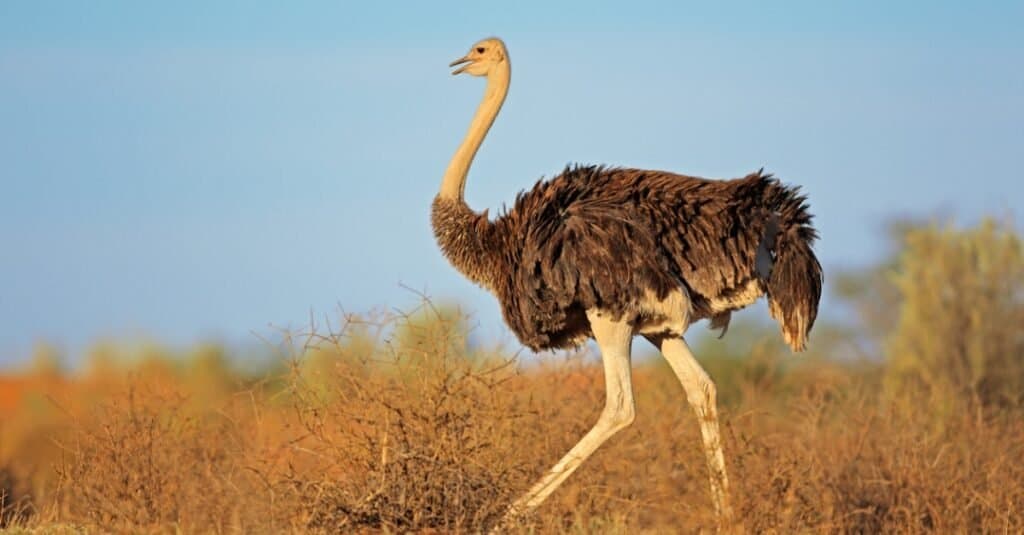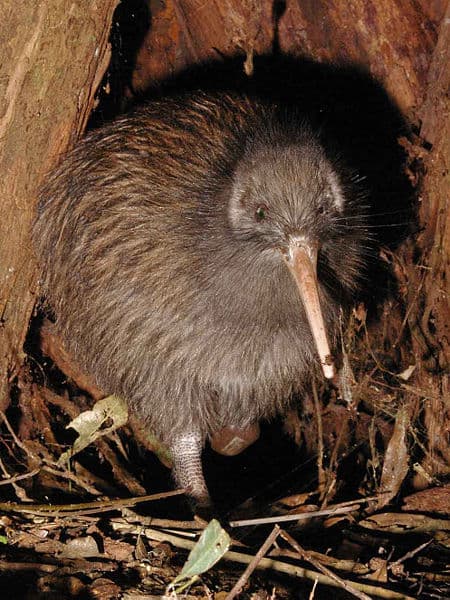What do you think of when you think of an egg? Do you think of the eggs that people typically eat, which come from chickens? Or do you think about human egg cells? Eggs are very often involved in reproduction, although mammals are very different from other animals in this way.
The yolk of the egg is actually very important for the development of the embryo. The embryo gets its nutrition from this yolk.
Even though many animals produce eggs, it’s interesting to think about the differences in these eggs. For example, which animal lays the largest egg? Read on to learn more about the animal that produces the largest egg in the world.
The Largest Egg in the World

The ostrich lays the largest egg in the world, with the average egg weighing three pounds and being six inches long.
©iStock.com/EcoPrint
The largest egg in the world is laid by the ostrich. The average egg of an ostrich weighs about three pounds, which for perspective is the weight of about 24 chicken eggs! Ostrich eggs are also approximately six inches long.
However, although this egg is larger than any other animal’s egg, it’s actually very small in proportion to the mother ostrich. In fact, among birds, the ostrich egg is the smallest when compared to the size of the adult bird. The egg is only 2% of the body weight of the mother ostrich. For comparison, a newborn human baby is about 5% of its mother’s body weight on average.
Additionally, even though the ostrich has the largest egg of any animal, scientists found that these eggs are only about 27% yolk on average, with 54% albumen and 19% shell. Ostrich eggs have lower percentages of yolk compared to other species, with chicken eggs being about 35% yolk when they are first incubated.
Considering that the yolk is the primary source of nutrition for the embryo, this could be why ostrich chicks are very dependent on their parents for a relatively long time – about two months.
After this, they become a little more independent, but they stay with the same flock until they are about seven months old. At this point, the birds are about six feet tall and large enough to protect themselves from any incoming danger.
How Are the Largest Eggs in the World Handled?

Female ostriches lay their eggs in a communal nest, and the dominant female incubates them; when they hatch, the male takes care of them.
©Dominique de La Croix/Shutterstock.com
In a group of ostriches, the male will make a lifelong mating pair with one dominant female. However, he will also mate with other females as well. Once mating is over, the male will dig a shallow hole.
All of the female ostriches will lay their eggs in that hole, which is now a communal nest. The dominant female’s eggs will be in the center, which is the optimum spot for growth of the eggs.
Then, the dominant female incubates all of the eggs, her own and those of the other females. Usually, she will discard the eggs from the weaker females, so that about 20 eggs are left. Incredibly, she is able to distinguish her own eggs from the eggs of other females. The other females leave and commence breeding attempts with another male ostrich.
It takes about 36 to 45 days for the eggs to be ready to hatch. Once the ostrich chicks hatch, it’s actually the males who take care of them. If two ostrich fathers cross paths, they will battle. The winner will take both sets of babies.
Scientists believe that this is because having more chicks around will increase the chance that an ostrich’s own offspring will survive if they all to come into contact with a predator.
Which Animal Lays the Largest Egg in the World Relative to Its Size?

The North Island brown kiwi is the bird that lays the biggest egg relative to its size, at 15% to 22% of the mother’s body weight.
©Maungatautari Ecological Island Trust – Public Domain
Even though the ostrich lays the largest egg, the egg is very small when we consider the size of the adult bird. However, there are birds that lay eggs that are very large compared to the size of the mother.
The bird that lays the biggest egg, considering its size, is the North Island brown kiwi. A female kiwi will lay an egg that is a whopping 15% to 22% of her body weight. Kiwi eggs are about six times bigger than the eggs of other birds that are similar in size.
Scientists don’t know exactly why the egg of the kiwi is so large. Some believe that the egg has gotten larger over time. Others believe that the kiwi was a much larger bird at one point; even though the adult bird became smaller over passing generations, the egg stayed the same size.
Many lean towards the latter theory, because evolution is more likely to preserve changes to the characteristics of an adult bird than it is to preserve changes to a fetus or egg. If this is the case, that ancestor of the kiwi would probably have been much larger, possibly about 4.9 feet (1.5 meters) tall. Today, the North Island brown kiwi is 1.5 to 2 feet (0.5 to 0.6 meters) tall.
The female brown kiwi lays multiple eggs per season, unlike other kiwis. Also, unlike the majority of birds, female brown kiwis each have two functioning ovaries. The male kiwi will incubate the egg for between 68 and 91 days before the chick hatches.
Advantages of a Large Egg Relative to Adult Size
When the kiwi chick hatches, it’s not long before it’s self-sufficient. The chick doesn’t imprint on its parents. This is likely a result of the size of the egg. Even though laying such a huge egg is painful for the mother, it allows for a lot of yolk.
While most birds’ eggs are between 35% and 40% yolk, the yolk of the kiwi egg is about 65% of the egg. The amount of nutrition in this yolk leads to kiwi chicks that are born highly developed, fully feathered, and relatively independent of their parents.
In fact, the yolk of the kiwi egg is so large that it can continue to provide them with nutrition for their first week of life. After that, the kiwi chicks are able to provide for themselves. Their parents rarely have to feed them.
The photo featured at the top of this post is © fullempty/Shutterstock.com
Thank you for reading! Have some feedback for us? Contact the AZ Animals editorial team.






